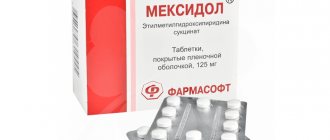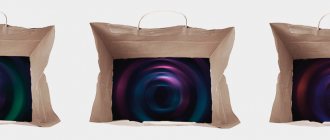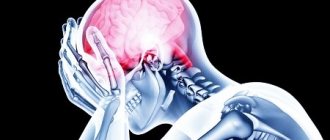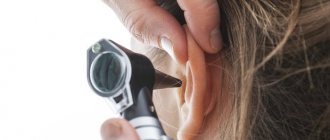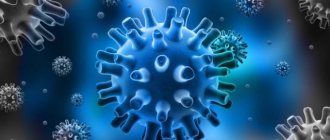Types of pressing headaches
Based on the pressure in the head, where the symptom is concentrated and what manifestations it is accompanied by, an experienced doctor is able to make a preliminary diagnosis. Unpleasant sensations can be caused by various pathological and physiological processes, so specific therapy is required in each case.
Neuralgic
In this case, a compressive headache becomes the result of pinched nerve endings. It usually appears in the back of the head and spreads to the crown. It can be unilateral or symmetrical.
It is often accompanied by numbness in certain areas of the face or fingers. It is often mild or moderate in severity, but can be intense. Sometimes accompanied by characteristic painful lumbago in the neck, temples, and jaws.
Vascular
This may be accompanied by painful pulsation in certain areas of the skull or over the entire area. The squeezing sensation is accompanied by dizziness, restlessness, irritability, or weakness.
Liquorodynamic
The brain is surrounded by cerebrospinal fluid, which protects the organ from negative external influences. Liquid is constantly formed, circulates in a confined space and is absorbed into the blood.
As a result of damage to internal organs, infectious diseases, traumatic brain injuries and a number of other issues, these processes can be disrupted, which leads to an increase in the volume of cerebrospinal fluid. Due to increased intracranial pressure, a person experiences a pressing, bursting pain that does not respond to taking antispasmodics and analgesics.
Often it is encircling, like a hoop that covers the entire skull.
Infectious-toxic
In this case, the patient’s head is compressed against the background of fever and deterioration in general health. The phenomenon is the result of poisoning the body with toxins or other harmful substances.
Cephalgia is constant, obsessive, persistent, without specific localization. She responds poorly to taking medications and using improvised means to relieve symptoms. You can completely get rid of it only by eliminating the cause of the disease.
Voltage
Something stirs in my head after stress
Psychosensory (sensory) disorders (Greek psyche - soul, Lat. sensorium - apparatus that perceives sensations, consciousness, “organ of consciousness”) - a consequence of a violation of sensory synthesis, leading to a distortion of complex perceptions of the external world and one’s own body while maintaining sensations received directly sense organs.
Described by the Soviet psychiatrist M. O. Gurevich (1933, 1936). According to M. O. Gurevich P. r. clearly differ from other forms of perceptual disorders (Nervous and mental disorders in closed skull injuries M., 1948).
They differ from agnosias in that recognition is not impaired; from hallucinations - because in the latter there is no real object of perception; from illusions - in that with the latter recognition is impaired, but illusory errors are easily corrected, in contrast to psychosensory errors, in which objects are recognized, but in a distorted form.
P. r. differ. and from simple sensory disturbances, in which phenomena of loss or irritation are observed, but not distortion as a result of disintegration, reduction to a lower level.
With the disintegration of psychosensory functions, not only are these synthetic forms of perception disrupted, but, in addition, pathological phenomena of disintegration are revealed in the form of distorted components that are part of the disturbed higher function. There is a distortion and violation of the completeness of perception of objects without violating their identification, i.e.
with correct recognition and, as a rule, a maintained critical attitude. Due to the loss of one or another component of perception (emotional, color, spatial, temporal), various depersonalization (relating to the perception of oneself and one’s body) and derealization (relating to the perception of the environment) symptoms arise.
These include: general depersonalization - a feeling of change in one’s “I”, general derealization - a feeling of alienation from the environment, micro and macropsia - the perception of objects reduced or enlarged, metamorphopsia - perception in a distorted form, disorder of the “body diagram” - a distortion of the sense of the shape and size of oneself of the body or its individual parts, xanthopsia - perception in yellow light, erythropsia - in red light, as well as disturbances in the sense of space, time, weight of one’s body, etc. Already seen, heard, experienced symptoms - a type of P. r., consisting in a feeling of familiarity experienced for the first time as a result of a violation of the integrity of perception and time (French names for these phenomena have become widespread in Russian literature: respectively, deja vu, deja entendu, deja vecu). The opposite state - never seen, never heard, never experienced (jamais vu, entendu, vecu) consists of a feeling of novelty with apparently repeated perceptions or experiences. Often P. r. act as a component of the psychoorganic syndrome, and their combination in the form of disturbances in the body diagram and metamorphopsia, the development of which leads to depersonalization and derealization, became known as the interparietal syndrome of M. O. Gurevich (1933). Psychosensory attacks considered to be close to epilepsy include migraine attacks, Meniere-like attacks, and umbilical colic in children.
Etc. usually develop paroxysmally, and disintegration in most cases ends with reintegration, restoring the function of perception.
These disorders are the result of local organic lesions or functional disorders of blood and liquor circulation.
They are observed in various organic diseases of the central nervous system: epidemic encephalitis, epilepsy, arachnoiditis, tumors, syphilis, as well as paraorganic disorders in schizophrenia.
source
Why goosebumps appear on the head: the reason for the unusual sensation
The feeling of goosebumps running through the head is familiar to a huge number of people. This sensation appears on the skin when the receptors are irritated.
This condition can be explained by a sharp decrease or increase in air temperature.
It also occurs when the circulatory system is disrupted and other diseases.
The mechanism of sensation
The appearance of a crawling sensation on the scalp is observed if the conduction of impulses along the nerves is disrupted. This happens when nerve endings are irritated. If the small subcutaneous muscles that attach to the hair follicles contract, the person feels like goosebumps are running over the head. This unpleasant condition is called paresthesia. The condition occurs with goose bumps.
The appearance of goosebumps on the back of the head or in other parts of the head can be caused by various sensations:
- satisfaction;
- fear;
- excitement;
- admiration;
- delight;
- pleasure.
The appearance of paresthesia is observed when exposed to environmental factors or when certain diseases occur.
Source: https://hpt-kld.ru/v-golove-chto-to-shevelitsya-posle-stressa/
Diagnostics
Any headache of a different nature cannot be ignored, since this is how the body signals the presence of any malfunctions in the body, which a comprehensive examination will help to identify.
Diagnostic methods:
- clinical blood test - helps to see the presence of inflammatory processes in the body, determine the level of hemoglobin;
- CT, MRI, REG - these hardware examination methods help assess the functional state of the brain;
- Doppler examination of blood vessels - shows the presence of plaques, blood clots;
- ECG – performed for vascular pathologies;
- measurement of intracranial pressure.
Why do you get a feeling of goosebumps on your head?
The feeling of goosebumps running through the head is familiar to a huge number of people. This sensation appears on the skin when the receptors are irritated.
This condition can be explained by a sharp decrease or increase in air temperature.
It also occurs when the circulatory system is disrupted and other diseases.
Goosebumps as a sign of illness
The reasons for the appearance of a pathological condition most often lie in the development of certain diseases in the body. The sensation of hair moving on the head occurs when:
- osteochondrosis. In case of disease of the cervical spine, compression of the nerve roots leads to an unpleasant sensation in the back of the head;
- Bell's palsy. Goose bumps appear against the background of an inflammatory process in the facial nerve. The muscles gradually weaken, and after a certain time they lose mobility. When sick, patients complain that they have a headache behind the ear;
- diseases of the heart and blood vessels. The cause of the disorder is arterial hypertension. Increased blood pressure leads to poor circulation. The pathology is accompanied by pale skin and nausea.
- vitamin deficiency. When vitamins enter the human body in insufficient quantities, disturbances in the functioning of the body are observed. Patients complain of muscle weakness, peeling and irritation of the skin;
- hypoparathyroidism. If the parathyroid glands do not work properly, this leads to disruption of the nervous system. The disease also causes numbness in the extremities and follicular hyperkeratosis. Signs of pathology include the appearance of scales on the skin that cover the hair follicles. The sebaceous glands secrete a certain substance, which leads to gluing of the scales. Inflammation develops, causing goosebumps. Hyperkeratosis appears due to improper care of the scalp;
- atherosclerosis. The pathology is accompanied by pale skin and trophic ulcerative lesions;
- colds. Unpleasant sensations are provoked by a cold, which leads to a decrease in the body's defenses.
There are a huge number of diseases against which unpleasant sensations develop. And sometimes additional manifestations, such as various pimples on the head. That is why it is recommended to carry out their timely treatment.
When goose bumps are not a symptom
The feeling of goosebumps on the head often appears when exposed to irritating environmental factors. If the pathology is accompanied by tingling in the back of the head and other parts of the head, then the reasons lie in psycho-emotional stress. Paresthesia appears when:
- stress;
- delighted;
- overexcitement;
- fear.
If a person has overly sensitive nerves, this can cause an unpleasant symptom. Excessively low air temperature leads to goosebumps on the skin. If there is a lack of B vitamins in the body, a person may also experience this sensation.
Goosebumps occur during sexual arousal. If, against the background of hypothermia, the body temperature rises, this becomes the cause of an unpleasant condition. Often the appearance of goosebumps is observed when you feel unwell. People who experience a loss of strength are at risk.
If the above factors become the cause of goosebumps, then the patient needs to eliminate the influence of the provoking factor. This will eliminate the symptom as quickly as possible.
Diagnosis and treatment
In order to ensure proper treatment of goosebumps on the head, it is necessary to determine the causes of their appearance and the accompanying symptoms (for example, itching of the scalp). Diagnosis requires the use of a variety of methods. First you need to consult a trichologist and dermatologist.
After collecting anamnesis and examining the patient, specialists can make a preliminary diagnosis. To confirm it, it is recommended to use instrumental and laboratory examination methods. Patients are recommended to undergo a biochemical blood test to determine the level of:
- microelements;
- lipids;
- hormones;
- glucose.
The patient also undergoes a general blood and urine test. Patients are recommended to undergo radiography of the cervical spine, neuromyography, and brain tomography. In some cases, rheoencephalography, electrocardiography and ultrasound are prescribed.
Thanks to diagnostic measures, it is possible to develop an effective treatment regimen. When a symptom appears, it is recommended to use:
- vasodilators. With the help of these drugs, blood circulation in the brain improves;
- antihypoxants;
- Angioprotectors. With the help of medications, blood vessels are strengthened and their tone is maintained;
- Statins. The use of drugs is recommended to slow down atherosclerotic processes; vitamins. With their help, tissue trophism and the passage of nerve impulses are improved. It is recommended to take magnesium, potassium, thiamine, and B vitamins.
If the cause of the symptom is diabetic neuropathy, then hypoglycemic medications are necessary. At the same time, diet therapy is used, which consists of excluding foods with a high hypoglycemic index from the diet. There should be short breaks between meals.
A head massage will relieve stress and tension. It can be easily performed by any patient independently.
For multiple sclerosis, it is recommended to treat with B vitamins. Patients are also recommended to undergo immunotherapy. Thanks to these drugs, the excessive activity of auto-aggressive particles that damage nerve tissue is blocked.
Finally
The appearance of a feeling of goosebumps running through the head indicates a violation of a person’s health condition. The symptom can also occur under the influence of environmental factors.
To determine the cause of the pathology, the patient is recommended to visit a doctor. Only a specialist will prescribe treatment in accordance with the individual characteristics of the patient.
Source: https://golovnie-boli.com/bolezni-golovy/pochemu-poyavlyaetsya-oshhushhenie-murashek-na-golove.html
Features of treatment
If a patient constantly complains that he has a heavy head, the causes of discomfort are vegetative-vascular dystonia, osteochondrosis or another disease, it is best to entrust treatment to a specialist. The following therapeutic measures are carried out:
- Cerebral circulation is normalized with the help of nootropic and vasotropic drugs.
- Blood circulation is improved with the help of physiotherapy: electropheresis, phonopharesis, and magnetic therapy are used.
- Muscle spasms in cervical osteochondrosis are relieved through massage and manual therapy.
- Nervous tension is eliminated - with the help of tranquilizers, sedatives, sedatives.
- To relieve muscle spasms, muscle relaxants are taken, non-steroidal anti-inflammatory gels and ointments are applied topically.
- Allergic reactions are relieved with antihistamines.
If the cause of discomfort is the growth of a tumor, surgical intervention may be required.
After the diagnosis of the disease has been made and the causes of cephalgia have been established, appropriate therapy is carried out. The list of treatment measures is established by the doctor. Even the use of traditional medicine is best coordinated with a specialist, so as not to aggravate the situation or neutralize the effect of the drugs.
Methods for eliminating the symptom depend on the factors that provoke it:
- for migraines, the doctor selects the optimal painkillers - triptans, ergotamines, analgesics, NSAIDs;
- in case of hypertension, it is necessary to reduce blood pressure to normal levels - antihypertensive drugs, diuretics and herbs are used;
- headaches due to tension and stress are treated with massage, taking sedatives, physical therapy and, if necessary, antispasmodics;
- for hormonal problems, therapy is coordinated with an endocrinologist;
- one-time manifestations of cephalgia are relieved by taking NSAIDs, antispasmodics or analgesics;
- for osteochondrosis, massage and exercise therapy methods are used. Drug therapy is carried out aimed at relieving pain and restoring the structure of cartilage tissue.
Even if it seems that the cause of the headache is obvious, it is necessary to undergo a full diagnosis under the supervision of a specialist. It will confirm or refute suspicions, eliminate the risks of complications and the transition of an acute disease to a chronic one, and will identify concomitant diseases.
Causes of goosebumps in the head
Paresthesia is a sensitivity disorder associated with damage to parts of the nervous system.
The reasons for the sensation of goose bumps in women and men correlate with diseases of the nervous system or circulatory disorders.
Short-term disturbances can be provoked by factors such as prolonged stay in an uncomfortable position, a stressful situation, hypothermia, irritation of superficial nerve endings (impact, compression).
Characteristics of the condition
The nervous system is divided into central and peripheral sections. The peripheral section includes nerve structures located outside the brain (brain, spinal column).
Damage to sensory nerve fibers, which form the basis of many cranial nerves, leads to sensory disturbances.
Regardless of the location of the area of damage to the nerve branches, sensory disturbances in the head area may occur.
The feeling of goosebumps running all over your head is often associated with mononeuropathy (damage to a single nerve) or polyneuropathy (damage to several nerve endings). The prevalence of polyneuropathy among the population is 2.4%; among patients over 60 years of age, the pathology is more common (8% of cases). The disease is based on diffuse damage to nerve endings.
Acute, subacute, and chronic forms are distinguished depending on the severity of symptoms and the speed of the disease. With axonopathy, damage occurs to the axial cylinder of the nerve branch; with myelinopathy, the myelin sheath encircling the nerve fiber is destroyed.
Clinically, the pathology is manifested by a sensation of pins and needles on the scalp and in other parts of the body, depending on the area of damage to the sensory fibers. In addition to the appearance of goosebumps, other signs of sensitivity disorder occur - numbness, burning, tingling. A condition where goosebumps run across the face is often associated with neuropathy of the facial nerve.
Causes
Often, neuropathy, accompanied by a feeling that the hair on the head is moving and goose bumps are running in the head, is a secondary condition that develops against the background of a primary disease, which suggests the need for differential diagnosis. The pathogenesis of neuropathy involves processes such as destruction of the myelin sheath, damage, and changes in the morphological structure of the nerve trunk.
Against the background of pathological changes in the connective tissue nerve sheaths, vasodilation and exudate are released, which leads to the occurrence of perivascular edema and foci of hemorrhage. The reasons why you get goosebumps are associated with pathological processes and conditions:
- Neurodegenerative changes.
- Autoimmune reactions (Guillain-Barré syndrome, multiple sclerosis).
- Nervous system infections.
- Tumors localized in the medulla.
- Intoxication associated with infectious diseases (diphtheria) or toxic substances (organophosphorus insecticides used in agriculture, heavy metals, for example, thallium).
Mononeuropathy develops due to compression of the nerve ending. Compression of nerve fibers often occurs due to the formation of a space-occupying lesion (tumor, cyst, hematoma).
Compression of nervous tissue is often carried out by bone structures - vertebral discs, protruding bones of the elbow, knee, and hand.
Compression can occur during sleep or after a long stay in an uncomfortable position (in the garden, while playing board games, at a computer desk).
If the pressure on the nerve branch is insignificant, clinically the pathology manifests itself only as a sensitivity disorder. With strong compression, muscle weakness (paresis, paralysis) is revealed.
The reasons for crawling on the back of the head may be associated with hypothermia of the neck or degenerative changes in the bone structures of the spinal column, which causes pinching and development of occipital nerve neuropathy.
Possible diseases
If goose bumps appear regularly, it is necessary to consult specialist doctors (neurologist, endocrinologist, therapist, cardiologist and others) who will find out why the symptoms of sensitivity disorder occur. Common diseases accompanied by similar symptoms:
- Vitamin deficiency (Thiamin - B1, Pyridoxine - B6, Cyanocobalamin - B12, vitamin E, Nicotinic acid - PP). It manifests itself as a combination of sensory and motor disorders, ataxia of sensitive origin, and the development of dementia.
- Atherosclerotic vascular lesions. The cause of goosebumps and dizziness is often associated with impaired cerebral blood flow, which occurs due to deterioration in the patency of the arteries supplying the brain.
- Diabetes. Diabetic polyneuropathy is a common form of pathology, which is detected in 30% of patients with symptoms such as goosebumps on the body and in the head area. Peripheral nerve damage is a common complication of diabetes, along with kidney dysfunction and eye damage.
- Thyroid dysfunction. The cause of polyneuropathy, manifested by a feeling of pins and needles all over the body and head, is hypothyroidism, a diagnosis that requires immediate and correct treatment. Hypothyroidism is a condition characterized by persistent deficiency of thyroid hormones. In addition to the feeling as if someone is crawling on your head, the disease is manifested by other symptoms - increased fatigue, lethargy, drowsiness, deterioration of memory and mental activity. Signs may be observed: dry skin, brittle nails and hair, rough voice.
- Liver dysfunction (cirrhosis, viral hepatitis). The crawling sensation associated with liver damage is accompanied by signs of malfunction of the autonomic system - heart rhythm disturbances, instability of blood pressure, often orthostatic hypotension (a sharp decrease in blood pressure when trying to stand up), decreased sweating, pallor, dry skin.
- Guillain-Barre syndrome. If the cause of the sensation of goosebumps in the head is acute polyneuropathy of inflammatory origin, accompanying symptoms are observed (tetraparesis - muscle weakness in all extremities, paresis of facial muscles, decreased muscle tone up to muscle atrophy, weakened tendon reflexes). Many patients have dysphagia (impaired swallowing) and oculomotor disorders.
- Shingles. The disease develops due to infection with a neurotropic virus. Hypothermia of the body provokes activation of the virus. A focus of inflammation occurs in the cranial and spinal nerve ganglia. The inflammatory process proceeds in the direction of the peripheral nerves, spreading to nerve endings in different parts of the body and head. Symptoms appear - increased body temperature, pain in the area of innervation of the affected nerve node or branch. Vesicles form on the skin, which suppurate followed by the formation of pustules.
If you have goosebumps on your head, this means that the possible cause of the condition is related to intoxication of the body.
The most common form of intoxication is alcoholic polyneuropathy (provoked by ethyl alcohol poisoning). Diagnosed in 30-70% of cases in the total mass of polyneuropathies caused by intoxication.
In addition to the feeling of goosebumps and numb limbs, cramps in the muscles of the legs and feet are often observed.
Neuropathy (damage) of the facial nerve is associated with hypothermia, trauma, inflammatory, infectious diseases of the otolaryngological sphere (otitis media, tonsillitis), inflammatory processes in the area of the meninges, tumors localized in the area of the base of the skull. Associated symptoms are observed - lagophthalmos (the eyelids do not close completely), paresis of facial muscles, disruption of the lacrimal glands.
Among other reasons for the condition that causes goose bumps in the head and body, it is worth highlighting renal failure, osteochondrosis, injuries in the skull and neck, spondylolisthesis (displacement of a vertebra relative to the element of the spinal column located below) or a tumor. Having found out why goosebumps are running all over the body, the doctor prescribes treatment taking into account the nature of the disease and its symptoms.
Temporary etiology
If the answer to the question why the head goes numb and goose bumps under the skin indicates temporary provoking factors (uncomfortable posture while sleeping or working, hypothermia, stressful situation), usually the condition does not require special treatment. Elimination of provoking factors, proper rest, and taking non-steroidal anti-inflammatory drugs (Ibuprofen) will help restore good health.
If your neck is blown in a draft, an alcohol compress or exposure to heat (wrapping in a scarf) will help eliminate the unpleasant tingling sensation in the back of the skull. Under stress, a narrowing of the head vessels occurs, which means a disruption of the blood supply to the brain tissue on the left or right side of the head.
The result is a feeling of goosebumps. To get rid of this symptom, just relax and calm down. For this purpose, take sedatives (Persen, Novo-Passit) or drink decoctions based on medicinal plants with a calming effect (mint, lemon balm, motherwort, valerian root).
Treatment methods
Treatment of conditions where goosebumps run over the head, face and body is carried out taking into account the causes of the sensitivity disorder. Basic principles and directions:
- Treatment of the primary disease that provoked the disorders.
- Elimination of painful sensations (if any).
- Physiotherapeutic procedures (electrophoresis, magnetotherapy, laser therapy).
Treatment of sensory impairment in diabetes mellitus involves controlling glucose levels, which slows the progression of the primary disease and its complications.
If there is a deficiency of thyroid hormones, hormone replacement therapy is performed. If there is a lack of vitamins, vitamin complexes (Benfogamma, Milgamma) are prescribed.
For herpes zoster, antiviral drugs are used.
The goosebumps that run over the head during a cold can be removed using simple methods - drinking plenty of warm drinks, bed rest, taking antipyretic medications. Treatment of the condition, when it seems like goosebumps are running on the back of the head with atherosclerosis, involves taking correctors of lipid metabolism and cholesterol levels, vasodilators and strengthening the vascular wall of drugs.
Tumors and cystic formations are removed surgically. To eliminate violations, special orthoses and splints are used. Wearing medical devices prevents the development of contracture (stiffness, shortening) and muscle spasm. In some cases, methods are effective: massage, therapeutic exercises, reflexology.
Drug therapy
To treat sensitivity disorders, when there is a sensation of hair moving on the head, medications are prescribed, primarily painkillers and anti-inflammatory drugs (Indomethacin, Reopirin, Sedalgin), which eliminates pain and manifestations of paresthesia. Main groups of drugs:
- Antiepileptics, anticonvulsants (Carbamazepine, Clonazepam).
- Stimulators of metabolic processes (Solcoseryl, Actovegin).
- Antiviral (Acyclovir, Herpesin).
- Muscle relaxants (Baclofen, Mydocalm).
- Correctors for cerebral blood flow disorders (Cavinton, Vinpocetine).
Glucocorticoid drugs (Prednisolone, Hydrocortisone) are prescribed to suppress the autoimmune reaction. For polyradiculoneuritis, antibiotics are prescribed (Gentamicin, Benzylpenicillin). In case of toxic lesions, intravenous administration of Hemodez and Glucose is recommended (detoxification therapy).
To improve the transmission of nerve impulses in muscle tissue, Proserin (a cholinesterase inhibitor, effective for myasthenia gravis and movement disorders associated with damage to nerve fibers) is prescribed. In the treatment of alcoholic polyneuropathy, vasodilators (Xanthinol nicotinate, Bendazole) are prescribed.
ethnoscience
To treat sensitivity disorders at home, decoctions and infusions are used, prepared from chicory and parsley roots, lingonberries and cranberries, flax seeds and dill, nettle leaves, leaves and flowers of echinacea and lavender.
What to pay attention to
If you regularly experience a tingling sensation in the right or left side of your head, you need to pay attention to the accompanying symptoms. These include visual and hearing impairment, dysphagia (swallowing disorder), speech dysfunction, dizziness, imbalance, nausea and vomiting, and persistent sleep disturbance. Many of the symptoms listed indicate the presence of a disease.
To find out what gives you goosebumps, you need to make an appointment with a doctor. There are many diseases and conditions that lead to sensitivity disorders. Having found out the causes of the disorders, the correct treatment can be prescribed.
Source: https://golovmozg.ru/zabolevaniya/prichiny-oschuscheniya-murashek-v-golove
Preventing pressing headaches
Regular medical examinations and timely treatment of diseases will prevent you from encountering regular or prolonged attacks of pressing cephalalgia. Elderly people and people leading a sedentary lifestyle should pay special attention to their condition.
To avoid the appearance of a pressing headache, you need to lead a healthy lifestyle, get rid of bad habits, walk more - all these activities help maintain the health of the vascular system and keep muscles toned.

